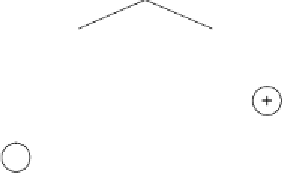Information Technology Reference
In-Depth Information
/+?+/*+?a?a????76296538-{6,0,0,7,0,7,0,4,8,4}-[ 9] = 825.5259
++-++?/????a?a?93181094-{2,4,5,4,0,6,3,4,2,9}-[10] = 765.1267
+/???aa?????a??82565470-{6,4,2,7,3,1,6,7,1,0}-[11] = 833.5259
//*++*+aa??a???82565470-{7,9,3,8,7,8,0,2,7,5}-[12] = 821.5384
+*//?a+?a?a??a?45251379-{8,7,5,9,3,7,5,7,0,2}-[13] = 669.5308
*//?a++??aa???a28979219-{8,7,5,9,3,8,5,7,0,2}-[14] = 722.7797
*//?a++?a?a???a79219799-{8,7,5,9,3,8,5,7,0,2}-[15] = 763.8067
+++-/++????a?a?00881327-{2,4,5,4,0,6,3,4,2,9}-[16] = 834.5455
*+/+a++??aa????76298530-{6,0,0,7,0,7,0,4,8,4}-[17] = 945.5585
+/?aa*-?aa???a?93035855-{6,9,2,7,3,1,6,7,1,0}-[18] = 825.5259
+a?/a*-?a????aa87027052-{6,9,2,7,3,1,6,7,1,0}-[19] = 822.5909
Note that the best of this generation and the best of the one before, despite
coding for very different expressions, not only share some sequence homol-
ogy (for instance, they differ just at one position in the Dc) but also share the
same set of random numerical constants. This most probably means that the
best program of this generation is a daughter of the best individual of the
previous generation.
a.
01234567890123456789012
*+/+a++??aa????76298530
b.
ET
C = {6, 0, 0, 7, 0, 7, 0, 4, 8, 4}
2
a
y
2
a
c.
a
2
a
a
4
0
0
4
Figure 5.11.
Best individual of generation 3 (chromosome 17). It has a fitness of
945.5585 evaluated against the set of fitness cases presented in Table 3.2.
a)
The
chromosome of the individual with its random numerical constants.
b)
The fully
expressed individual, meaning that the constants themselves and not their symbols
are shown in the ET.
c)
The corresponding mathematical expression.
In the next three generations there was no improvement in best fitness,
and the best individuals of all the three populations are all of them clones of
the best individual of generation 3; in fact, all of them were generated by
elitism (these chromosomes are highlighted in all the populations):









